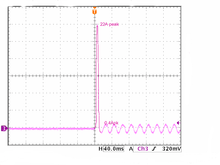Inrush current

Inrush current, input surge current or switch-on surge refers to the maximum, instantaneous input current drawn by an electrical device when first turned on. For example, incandescent light bulbs have high inrush currents until their filaments warm up and their resistance increases. Alternating current electric motors and transformers may draw several times their normal full-load current when first energized, for a few cycles of the input waveform. Power converters also often have inrush currents much higher than their steady state currents, due to the charging current of the input capacitance. The selection of overcurrent protection devices such as fuses and circuit breakers is made more complicated when high inrush currents must be tolerated. The overcurrent protection must react quickly to overload or short circuit but must not interrupt the circuit when the (usually harmless) inrush current flows.
Transformers
When a transformer is first energized, a transient current up to 10 to 15 times larger than the rated transformer current can flow for several cycles. Toroidal transformers, using less copper for the same power handling, can have up to 60 times inrush to running current. Worst case inrush happens when the primary winding is connected at an instant around the zero-crossing of the primary voltage, (which for a pure inductance would be the current maximum in the AC cycle) and if the polarity of the voltage half cycle has the same polarity as the remnance in the iron core has. (The magnetic remanance was left high from a preceding half cycle). Unless the windings and core are sized to normally never exceed 50% of saturation, (and in an efficient transformer they never are, such a construction would be overly heavy and inefficient) then during such a start up the core will be saturated. This can also be expressed as the remnant magnetism in normal operation is nearly as high as the saturation magnetism at the "knee" of the hysteresis loop. Once the core saturates however, the winding inductance appears greatly reduced, and only the resistance of the primary side windings and the impedance of the power line are limiting the current. As saturation occurs for part half cycles only, harmonic rich waveforms can be generated, and can cause problems to other equipment.
For large transformers with low winding resistance and high inductance, these inrush currents can last for several seconds until the transient has died away (decay time proportional to ~XL/R)and the regular AC equilibrium is established. To avoid magnetic inrush, only for transformers with an air gap in the core, the inductive load needs to be synchronously connected near a supply voltage peak, in contrast with the zero voltage switching which is desirable to minimize sharp edged current transients with resistive loads such as high power heaters. But for toroidal transformers only a premagnetising procedure before switching on allows to start those transformers without any inrush current peak.
Motors
When an electric motor, DC or AC, is first energised, the rotor is not moving, and a current equivalent to the stalled current will flow, reducing as the motor picks up speed and develops a back EMF to oppose the supply. AC induction motors behave as transformers with a shorted secondary, until the rotor begins to move, while brushed motors present essentially the winding resistance. The duration of the starting transient is less if the mechanical load on the motor is relieved until it has picked up speed.
For high power motors, the winding configuration may be changed (star at start and then delta) during start-up to reduce the current drawn.
Protection
A resistor in series with the line can be used to limit the current charging input capacitors. However, this approach is not very efficient, especially in high power devices, since the resistor will have a voltage drop and dissipate some power.
Inrush current can also be reduced by inrush current limiters. Negative temperature coefficient (NTC) thermistors are commonly used in switching power supplies, motor drives and audio equipment to prevent damage caused by inrush current. A thermistor is a thermally-sensitive resistor with a resistance that changes significantly and predictably as a result of temperature changes. The resistance of an NTC thermistor decreases as its temperature increases[1] .
As the inrush current limiter self-heats, the current begins to flow through it and warm it. Its resistance begins to drop and a relatively small current flow charges the input capacitors. After the capacitors in the power supply become charged, the self heated inrush current limiter offers little resistance in the circuit, with a low voltage drop with respect to the total voltage drop of the circuit. A disadvantage is that immediately after the device is switched off, the NTC resistor is still hot and has a low resistance. It cannot limit the inrush current unless it cools for more than 1 minute to get a higher resistance. Another disadvantage is that the NTC thermistor is not short circuit proof.
Another way to avoid the transformer inrush current is a "transformer switching relay". This does not need time for cool down. It can deal also with power line half-wave voltage-dips and is short circuit proof. This technique is Important for IEC 61000-4-11 tests.
Another option, particularly for high voltage circuits, is to use a pre-charge circuit. The circuit would support a current limited precharge mode during the charging of capacitors, and then switch to an unlimited mode for normal operation when the voltage on the load is 90% of full charge.
References
External links
- Ametherm Inrush Current Frequently Asked Questions
- IEC 61000–4–30, Electromagnetic Compatibility (EMC) – Testing and measurement techniques – Power quality measurement methods, Published by The International Electrotechnical Commission, 2003.